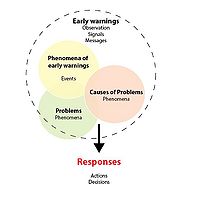Early warning signals in project management
(→Introduction) |
(→Introduction) |
||
| Line 10: | Line 10: | ||
==Introduction == | ==Introduction == | ||
| − | [[File:Early warning signal system.jpg| | + | [[File:Early warning signal system.jpg|200px|thumb|left|Figure 1: xxx]] |
Revision as of 13:57, 15 September 2015
Abstract
Despite the use of numerous methods and tools for ensuring the success of the development in the project management, still a large number of construction projects experience failure or critical situations. During the front-end stage project, a constant uncertainty last in all critical decisions and corrective actions to reduce possible undesirable impacts to the project.
Identify early warning signal in the early stage is important for the project success, since more time will be available to take corrective actions before negative consequences and problems occur.
An early weak signal can be a missing project information, lack of documentation or the typical wrong scheduling of activities and allocating workers. Due the level of uncertainty at this stage is not easy to identify early warning signs of potential problems that can arise during the development of the project. Nevertheless, select the right approaches for indicate the signals will aid the managers to take right decisions. Furthermore, weak signals can became stronger if they consider at the time of detection at early stages and anticipating problems.
The article explain the importance of early warning signals, compare with the theory of weak signals by Igor Ansoff (1975) and complemented by Nikander’s (2002) and enumerate the typical barriers to identify it.
Introduction
